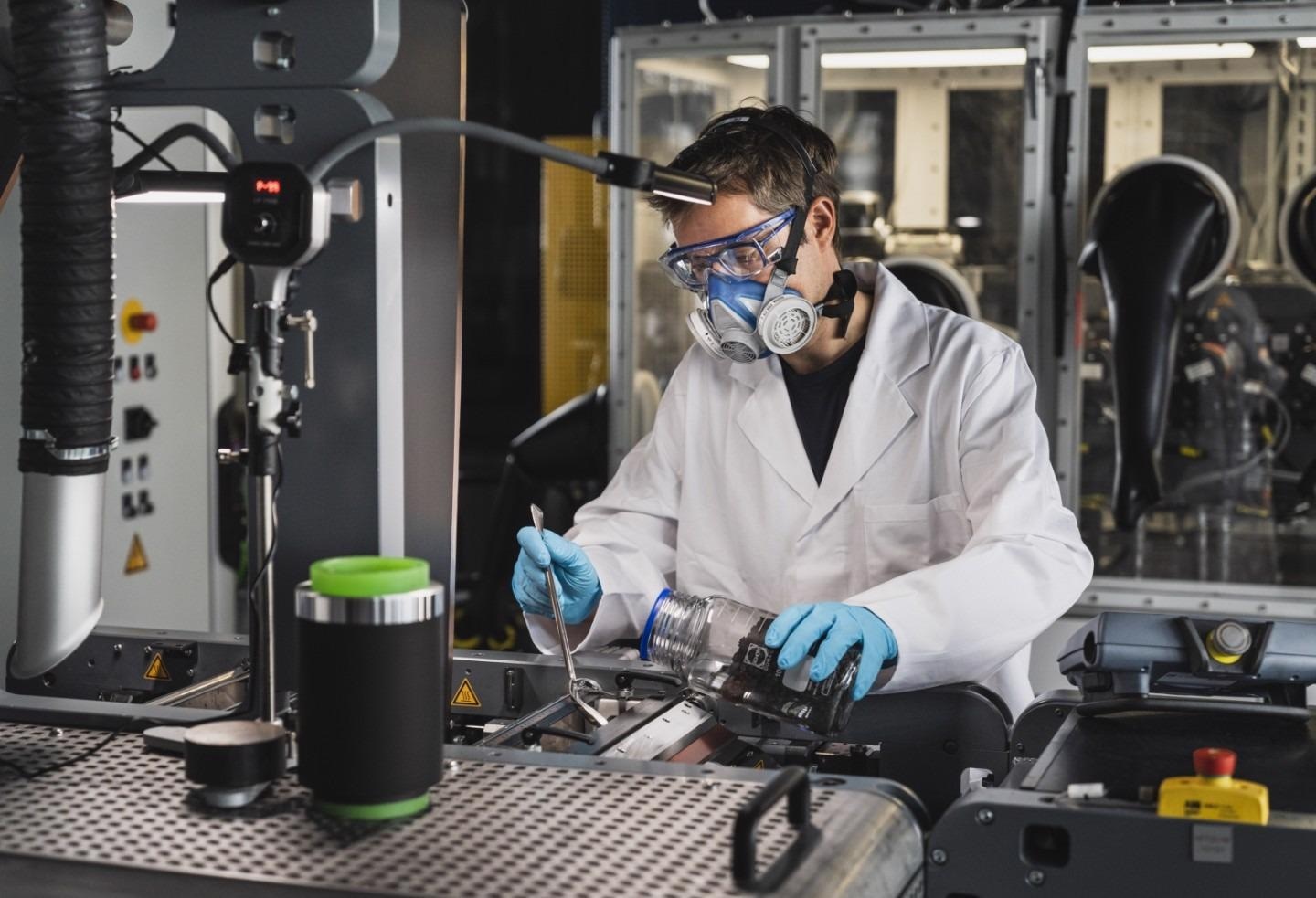Reviewed by Alex SmithSep 2 2021
Most of the traditional processes for producing battery electrodes involve toxic solvents and need a lot of space and energy. A new dry-coating process — DRYtraec® — formulated by the Fraunhofer Institute for Material and Beam Technology IWS resolves this issue.
 The dry coating powder is fed into the calender gap in the DRYtraec® machine. Image Credit: Fraunhofer IWS Dresden.
The dry coating powder is fed into the calender gap in the DRYtraec® machine. Image Credit: Fraunhofer IWS Dresden.
While being eco-friendly and economical, the technology can be applied on a large scale, thus offering the promise of completely transforming the manufacture of battery electrodes.
The Federal Ministry for Economic Affairs and Energy (BMWi) assumes that Germany will require nearly 655 terawatt-hours in the year 2030. This is almost 20% more than the current demand.
Prognos AG conducted a corresponding study on behalf of the ministry. The outcomes are an initial estimate, and the final estimates are expected to be released in the fall. Yet, it is evident that the energy requirement of society is continuously increasing.
The fast progression of the electromobility sector demands new approaches to lower the energy needed to produce batteries and, therefore, develop them to be economical and eco-friendly. DRYtraec® is a potential solution developed by an interdisciplinary research team at Fraunhofer IWS in Dresden that aims at the production of battery electrodes.
Electrodes are an important component of any battery and normally comprise a metal foil with a thin coating. This coating holds the active components that are capable of storing energy.
The conventional coating process uses a wet chemical method that applies what is known as slurry.
Dr. Benjamin Schumm, Group Manager for Chemical Coating Technologies, Fraunhofer IWS
The active material, binders and conductive carbon are distributed in a solvent to form a kind of paste. This paste is initially applied to the metal foil to create a wet coating.
Extremely large machines with very long drying tracks are needed to ensure that the solvent will evaporate afterward. With DRYtraec®, we can design this process more efficiently.
Dr. Benjamin Schumm, Group Manager for Chemical Coating Technologies, Fraunhofer IWS
Special Binder and Shear Forces from Rotating Rollers
The new coating process typically involves raw materials similar to those used in the slurry process. The dry coating technology created at Fraunhofer IWS does not need solvents. Rather, it uses a special binder for the process. The materials turn into a dry mixture, which is then fed into a calender gap, which is a gap between two rollers rotating in opposite directions.
An important detail is that one roller must turn faster than the other. This gives rise to a shear force, which ensures the formation of fibrils. Fibrils are thread-like networks formed in the binder.
Schumm says, “Imagine it as a spider’s web that mechanically embeds the particles.”
The motion and pressure form a fine film on the roller that rotates faster. This film is subsequently moved in a second calender gap onto a current collector foil. This enables both sides to be coated at the same time without much additional work. In the last stage, the resulting coil is cut to the required size, and the individual parts are stacked in a specific order to make the finished battery cell.
Success Thanks to Combined Expertise in Chemistry and Manufacturing Engineering
The DRYtraec® offers evident economic and ecological benefits over the existing battery electrode coating process. The elimination of toxic solvents and long, energy-intensive drying machines from the process has positive impacts on the environment.
Also, the new process speeds up the production and needs only one-third of the equipment space of a traditional solution, which saves costs in several ways. According to Schumm, the success of DRYtraec® is mainly due to the diversity of expertise in the research team at Fraunhofer IWS.
The team comprised members with a background in chemistry who worked on optimum powder mixture, but also experts in production engineering who developed equipment that prevents the dry film from ever being self-supporting. Thus, it ensures stability.
A Wide Range of Possible Applications
The first prototype DRYtraec® systems were set up as part of the “DryProTex” funding project. This project showed that it is possible to manufacture electrodes continuously, irrespective of the type of battery.
The range of possible uses for the technology is not limited to a particular cell chemistry. It could equally be used on lithium-ion cells as on lithium-sulfur or sodium-ion cells. We are even looking at solid-state batteries.
Dr. Benjamin Schumm, Group Manager for Chemical Coating Technologies, Fraunhofer IWS
“These will be increasingly important in the future, but the materials cannot tolerate wet chemical processing. Thus, DRYtraec® allows us to offer a very promising solution to this problem,” added Schumm.
The industry has given great attention to the process. Talks with various automobile and cell manufacturers are ongoing to draft the construction of several pilot systems. Apart from manufacturing electrodes with DRYtraec®, the researchers are working on several research projects to analyze the entire battery cell development process chain. Thus, they are making an important contribution in developing future batteries.